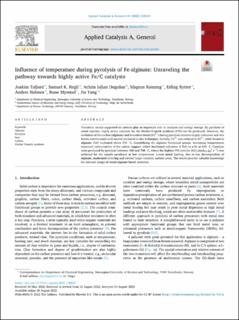| dc.contributor.author | Tafjord, Joakim | |
| dc.contributor.author | Regli, Samuel K. | |
| dc.contributor.author | Dugulan, Achim Iulian | |
| dc.contributor.author | Rønning, Magnus | |
| dc.contributor.author | Rytter, Erling | |
| dc.contributor.author | Holmen, Anders | |
| dc.contributor.author | Myrstad, Rune | |
| dc.contributor.author | Yang, Jia | |
| dc.date.accessioned | 2022-09-26T07:58:28Z | |
| dc.date.available | 2022-09-26T07:58:28Z | |
| dc.date.created | 2022-09-20T14:57:28Z | |
| dc.date.issued | 2022 | |
| dc.identifier.citation | Applied Catalysis A : General. 2022, 644 (118834), 1-12. | en_US |
| dc.identifier.issn | 0926-860X | |
| dc.identifier.uri | https://hdl.handle.net/11250/3021180 | |
| dc.description.abstract | Transition metals supported on carbons play an important role in catalysis and energy storage. By pyrolysis of metal alginate, highly active catalysts for the Fischer-Tropsch synthesis (FTS) can be produced. However, the evolution of the carbon (alginate) and transition metal (Fe3+) during pyrolysis remains largely unknown and was herein corroborated with several advanced in situ techniques. Initially, Fe3+ was reduced to Fe2+, while bound to alginate. FeO nucleated above 300 °C, destabilizing the alginate functional groups. Increasing temperatures improved carbonization of the carbon support, which facilitated reduction of FeO to α-Fe at 630 °C. Catalysts were produced by pyrolysis between 400 and 700 °C, where the highest FTS activity (612 µmolCO gFe−1 s−1) was achieved for the sample pyrolyzed at low temperature. Lower metal loading, due to less decomposition of alginate, moderated sintering and yielded larger catalytic surface areas. The results provide valuable knowledge for rational design of metal-alginate-based materials. | en_US |
| dc.language.iso | eng | en_US |
| dc.publisher | Elsevier | en_US |
| dc.rights | Navngivelse 4.0 Internasjonal | * |
| dc.rights.uri | http://creativecommons.org/licenses/by/4.0/deed.no | * |
| dc.subject | Fischer-Tropsch synthesis | en_US |
| dc.subject | Carbon | en_US |
| dc.subject | Iron | en_US |
| dc.subject | Pyrolysis | en_US |
| dc.subject | Alginate | en_US |
| dc.title | Influence of temperature during pyrolysis of Fe-alginate: Unraveling the pathway towards highly active Fe/C catalysts | en_US |
| dc.title.alternative | Influence of temperature during pyrolysis of Fe-alginate: Unraveling the pathway towards highly active Fe/C catalysts | en_US |
| dc.type | Peer reviewed | en_US |
| dc.type | Journal article | en_US |
| dc.description.version | publishedVersion | en_US |
| dc.rights.holder | © 2022 The Authors. Published by Elsevier B.V | en_US |
| dc.source.pagenumber | 12 | en_US |
| dc.source.volume | 644 | en_US |
| dc.source.journal | Applied Catalysis A : General | en_US |
| dc.identifier.doi | 10.1016/j.apcata.2022.118834 | |
| dc.identifier.cristin | 2053604 | |
| dc.relation.project | Norges forskningsråd: 296087 | en_US |
| dc.relation.project | Norges forskningsråd: 237922 | en_US |
| dc.relation.project | Norges forskningsråd:197405 | en_US |
| dc.source.articlenumber | 118834 | en_US |
| cristin.ispublished | true | |
| cristin.fulltext | original | |
| cristin.qualitycode | 1 | |

